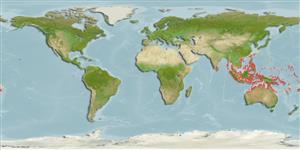Teleostei (teleosts) >
Tetraodontiformes (Puffers and filefishes) >
Tetraodontidae (Puffers) > Canthigasterinae
Etymology: Canthigaster: Greek, kanthos = the outer or inner corner of the eye, where the lids meet, 1646 + Greek, gaster = stomach (Ref. 45335).
Environment: milieu / climate zone / depth range / distribution range
Ecology
Marine; brackish; reef-associated; non-migratory; depth range 2 - 25 m (Ref. 90102). Tropical; 30°N - 21°S
Western Pacific: Philippines to the Solomon Islands, north to Ryukyu Islands and southern Marianas, south to Vanuatu.
Size / Weight / Age
Maturity: Lm ? range ? - ? cm
Max length : 12.0 cm SL male/unsexed; (Ref. 48637)
Inhabits sandy areas of shallow lagoons and channels (Ref. 9710, 48637). Also found in silty bays or harbors around wharf pilings. Adults usually in pairs (Ref. 48637).
Life cycle and mating behavior
Maturity | Reproduction | Spawning | Eggs | Fecundity | Larvae
Allen, G.R. and R. Swainston, 1992. Reef fishes of New Guinea: a field guide for divers, anglers and naturalists. Publication No. 8. Christensen Research Institute, Madang, Papua New Guinea. 132 p. (Ref. 6023)
IUCN Red List Status (Ref. 130435: Version 2024-1)
Threat to humans
Harmless
Human uses
Fisheries: of no interest
Tools
Can't connect to MySQL database fbquizv2. Errorcode: Too many connections
